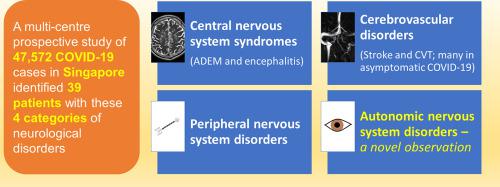当前位置:
X-MOL 学术
›
J. Neurol. Sci.
›
论文详情
Our official English website, www.x-mol.net, welcomes your feedback! (Note: you will need to create a separate account there.)
Neurology of COVID-19 in Singapore
Journal of the Neurological Sciences ( IF 4.4 ) Pub Date : 2020-11-01 , DOI: 10.1016/j.jns.2020.117118 Jasmine Shimin Koh , Deidre Anne De Silva , Amy May Lin Quek , Hui Jin Chiew , Tian Ming Tu , Christopher Ying Hao Seet , Rebecca Hui Min Hoe , Monica Saini , Andrew Che-Fai Hui , Jasmyn Angon , Justin Ruixin Ker , Ming Hui Yong , Yihui Goh , Wai-Yung Yu , Tchoyoson Choie Cheio Lim , Benjamin Yong Qiang Tan , Kay Wei Ping Ng , Leonard Leong Litt Yeo , Yu Zhi Pang , Kumar M. Prakash , Aftab Ahmad , Terrence Thomas , David Chien Boon Lye , Kevin Tan , Thirugnanam Umapathi
Journal of the Neurological Sciences ( IF 4.4 ) Pub Date : 2020-11-01 , DOI: 10.1016/j.jns.2020.117118 Jasmine Shimin Koh , Deidre Anne De Silva , Amy May Lin Quek , Hui Jin Chiew , Tian Ming Tu , Christopher Ying Hao Seet , Rebecca Hui Min Hoe , Monica Saini , Andrew Che-Fai Hui , Jasmyn Angon , Justin Ruixin Ker , Ming Hui Yong , Yihui Goh , Wai-Yung Yu , Tchoyoson Choie Cheio Lim , Benjamin Yong Qiang Tan , Kay Wei Ping Ng , Leonard Leong Litt Yeo , Yu Zhi Pang , Kumar M. Prakash , Aftab Ahmad , Terrence Thomas , David Chien Boon Lye , Kevin Tan , Thirugnanam Umapathi

|
Purpose To describe the spectrum of COVID-19 neurology in Singapore. Method We prospectively studied all microbiologically-confirmed COVID-19 patients in Singapore, who were referred for any neurological complaint within three months of COVID-19 onset. Neurological diagnoses and relationship to COVID-19 was made by consensus guided by contemporaneous literature, refined using recent case definitions. Results 47,572 patients (median age 34 years, 98% males) were diagnosed with COVID-19 in Singapore between 19 March to 19 July 2020. We identified 90 patients (median age 38, 98.9% males) with neurological disorders; 39 with varying certainty of relationship to COVID-19 categorised as: i) Central nervous system syndromes-4 acute disseminated encephalomyelitis (ADEM) and encephalitis, ii) Cerebrovascular disorders-19 acute ischaemic stroke and transient ischaemic attack (AIS/TIA), 4 cerebral venous thrombosis (CVT), 2 intracerebral haemorrhage, iii) Peripheral nervous system-7 mono/polyneuropathies, and a novel group, iv) Autonomic nervous system-4 limited dysautonomic syndromes. Fifty-one other patients had pre/co-existent neurological conditions unrelated to COVID-19. Encephalitis/ADEM is delayed, occurring in critical COVID-19, while CVT and dysautonomia occurred early in relatively mild infection. AIS/TIA was variable in onset, occurring in patients with differing COVID-19 severity; remarkably 63.2% were asymptomatic. CVT was more frequent than expected and occurred in mild/asymptomatic patients. There were no neurological complications in all 81 paediatric COVID-19 cases. Conclusion COVID-19 neurology has a wide spectrum of dysimmune-thrombotic disorders. We encountered relatively few neurological complications, probably because our outbreak involved largely young men with mild/ asymptomatic COVID-19. It is also widely perceived that the pandemic did not unduly affect Singapore healthcare system.
中文翻译:

新加坡 COVID-19 的神经病学
目的 描述新加坡 COVID-19 神经病学的范围。方法 我们前瞻性地研究了新加坡所有经微生物学确诊的 COVID-19 患者,这些患者在 COVID-19 发病后三个月内因任何神经系统疾病而被转诊。神经学诊断和与 COVID-19 的关系是在同期文献的指导下达成的共识,并使用最近的病例定义进行了改进。结果 2020 年 3 月 19 日至 7 月 19 日期间,新加坡有 47,572 名患者(中位年龄 34 岁,98% 为男性)被诊断出患有 COVID-19。我们确定了 90 名患有神经系统疾病的患者(中位年龄为 38 岁,98.9% 为男性);39 与 COVID-19 的关系确定性不同,分类为:i) 中枢神经系统综合征 - 4 急性播散性脑脊髓炎 (ADEM) 和脑炎,ii) 脑血管疾病 - 19 急性缺血性中风和短暂性脑缺血发作 (AIS/TIA),4 脑静脉血栓形成 (CVT),2 脑出血,iii) 周围神经系统 - 7 单/多发性神经病,以及一个新组,iv) 自主神经神经系统 - 4 限制性自主神经综合征。其他 51 名患者患有与 COVID-19 无关的神经系统疾病。脑炎/ADEM 发生延迟,发生在严重的 COVID-19 中,而 CVT 和自主神经功能障碍发生在相对较轻的感染早期。AIS/TIA 的发病率是可变的,发生在 COVID-19 严重程度不同的患者中;值得注意的是,63.2% 的人没有症状。CVT 比预期更频繁,发生在轻度/无症状患者中。所有 81 例儿科 COVID-19 病例均未出现神经系统并发症。结论 COVID-19 神经病学具有广泛的免疫障碍性血栓性疾病。我们遇到的神经系统并发症相对较少,可能是因为我们的爆发主要涉及患有轻度/无症状 COVID-19 的年轻男性。人们也普遍认为,大流行并没有对新加坡的医疗保健系统造成过度影响。
更新日期:2020-11-01
中文翻译:

新加坡 COVID-19 的神经病学
目的 描述新加坡 COVID-19 神经病学的范围。方法 我们前瞻性地研究了新加坡所有经微生物学确诊的 COVID-19 患者,这些患者在 COVID-19 发病后三个月内因任何神经系统疾病而被转诊。神经学诊断和与 COVID-19 的关系是在同期文献的指导下达成的共识,并使用最近的病例定义进行了改进。结果 2020 年 3 月 19 日至 7 月 19 日期间,新加坡有 47,572 名患者(中位年龄 34 岁,98% 为男性)被诊断出患有 COVID-19。我们确定了 90 名患有神经系统疾病的患者(中位年龄为 38 岁,98.9% 为男性);39 与 COVID-19 的关系确定性不同,分类为:i) 中枢神经系统综合征 - 4 急性播散性脑脊髓炎 (ADEM) 和脑炎,ii) 脑血管疾病 - 19 急性缺血性中风和短暂性脑缺血发作 (AIS/TIA),4 脑静脉血栓形成 (CVT),2 脑出血,iii) 周围神经系统 - 7 单/多发性神经病,以及一个新组,iv) 自主神经神经系统 - 4 限制性自主神经综合征。其他 51 名患者患有与 COVID-19 无关的神经系统疾病。脑炎/ADEM 发生延迟,发生在严重的 COVID-19 中,而 CVT 和自主神经功能障碍发生在相对较轻的感染早期。AIS/TIA 的发病率是可变的,发生在 COVID-19 严重程度不同的患者中;值得注意的是,63.2% 的人没有症状。CVT 比预期更频繁,发生在轻度/无症状患者中。所有 81 例儿科 COVID-19 病例均未出现神经系统并发症。结论 COVID-19 神经病学具有广泛的免疫障碍性血栓性疾病。我们遇到的神经系统并发症相对较少,可能是因为我们的爆发主要涉及患有轻度/无症状 COVID-19 的年轻男性。人们也普遍认为,大流行并没有对新加坡的医疗保健系统造成过度影响。



























 京公网安备 11010802027423号
京公网安备 11010802027423号